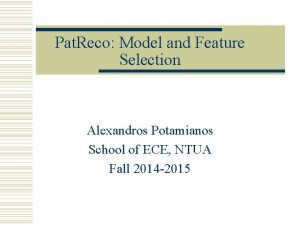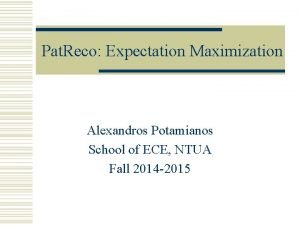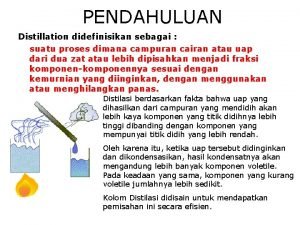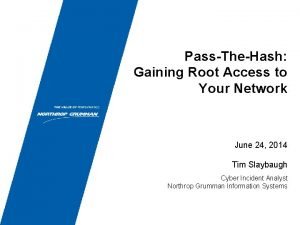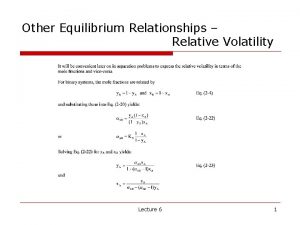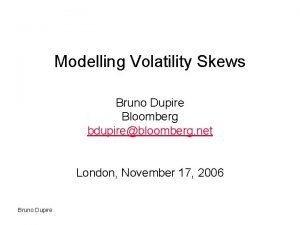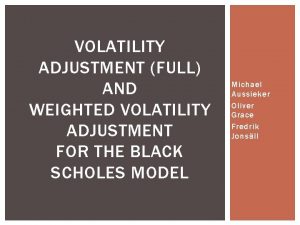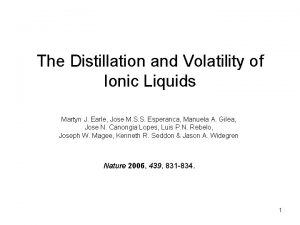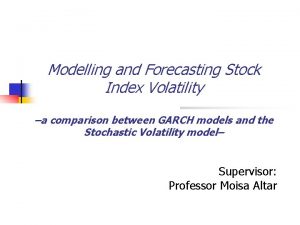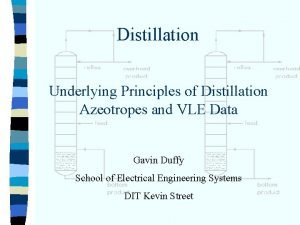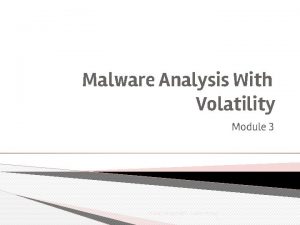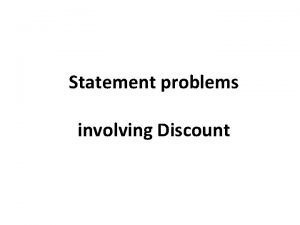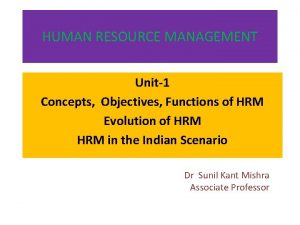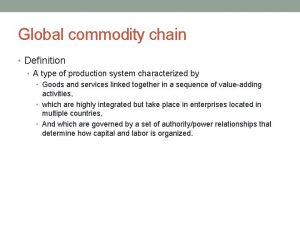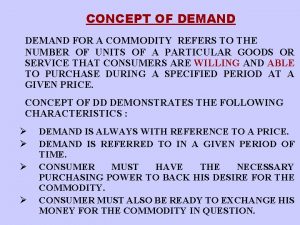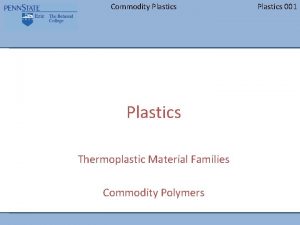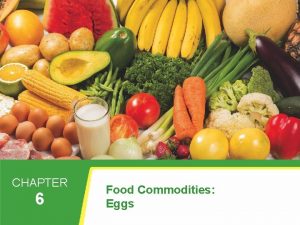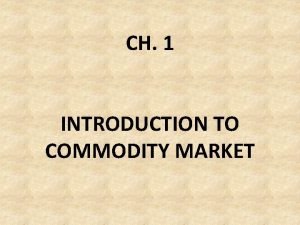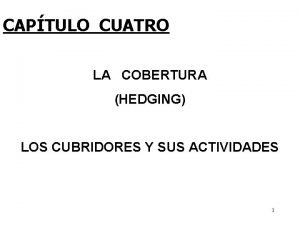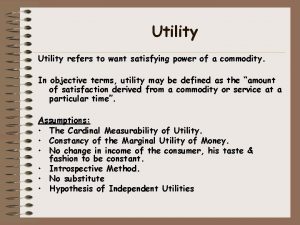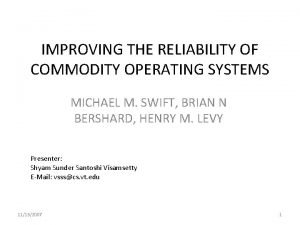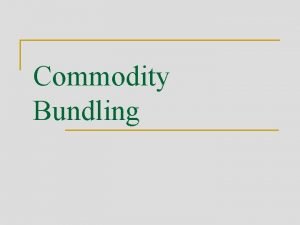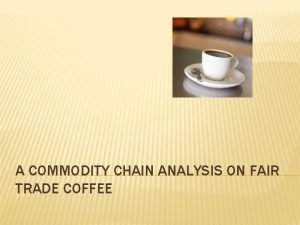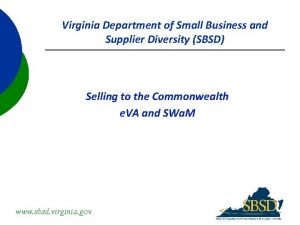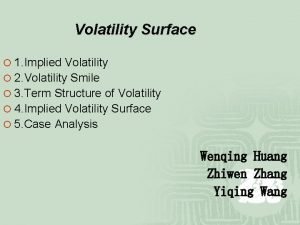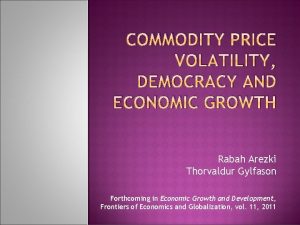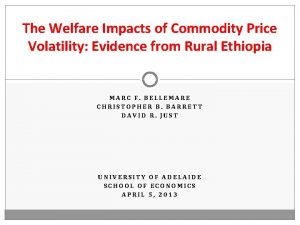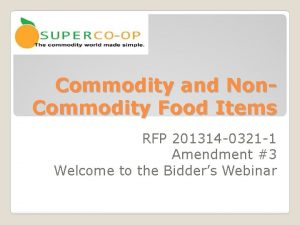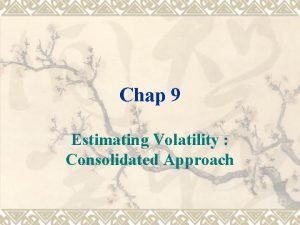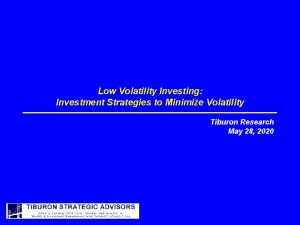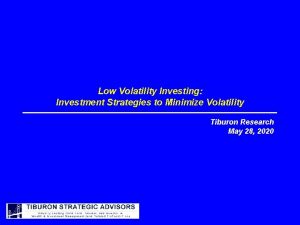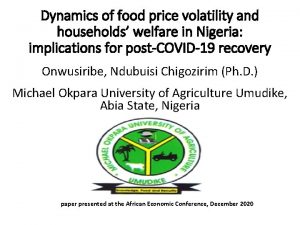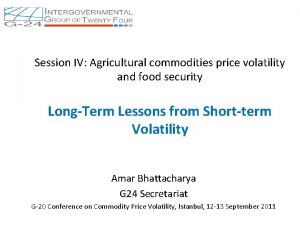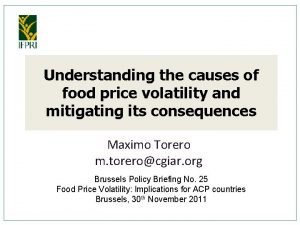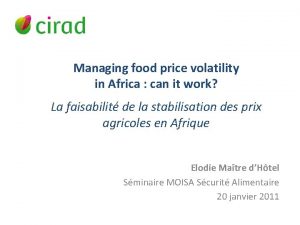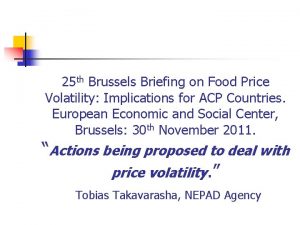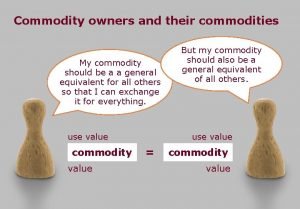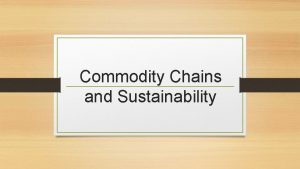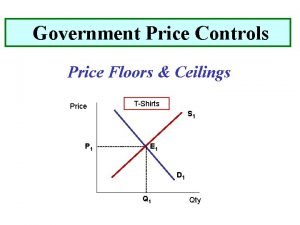Food commodity price volatility and food insecurity Alexandros














































- Slides: 46

Food commodity price volatility and food insecurity Alexandros Sarris Professor of economics, University of Athens, Greece February 2014

Plan of presentation • • Food commodity market volatility and why it matters Nature of commodity prices and volatility The EU context Volatility risks faced by developing country food importers How to define excessive market volatility and crises Can market volatility and crises be prevented or reduced and how? Policies to manage price volatility Priorities for action by the international community to assist developing countries to deal with continuing food market volatility?

Global food commodity price volatility has been unusually high in last five years. World food commodity price index 1990 -2011 (FAO)

Recent year wheat prices

Recent year maize prices

Oilseed prices 2005 -2012

Cereal commodity prices in long term perspective (current prices)

Cereal commodity prices in long term perspective (real prices)

Volatility matters for developing countries because of increasing exposure. Medium term OECD-FAO projections of agricultural production and trade LDC Countries (Base 1999 -2001 =1)

Medium term OECD-FAO projections of agricultural production and trade for other developing countries (non-LDC, non-BRIC) (Base 1999 -2001 =1)

Cereal import dependence 2007 -9 (number of countries with percentage share of imports to total domestic supply in given range)

Conceptual issues • What matters for market participants is uncertainty, namely ex-ante unpredictability and not ex-post variability • Risk is determined by exposure to uncertainty or unpredictability • Unpredictability not easily measured, while expost variability readily measured • Impacts of volatility on DCs large at both micro and macro levels because of large dependence on primary food commodities and credit constraints at both micro and macro levels

Issues relevant to agricultural commodity prices and volatility • • • Do commodity prices have trends? Are shocks temporary or permanent? Are shocks persistent? Do agricultural market prices comove? Nature of unanticipated shocks Volatility best measured by forward looking measures, such as conditional variance of future prices (eg. via GARCH estimates) or implied volatilities from options data

What does the literature say • Small negative real trends but depends on time period. Signal to noise ratio small. • Tests of temporary or permanent trends have low power. • Trends seem variable hence uncertain. • Shocks and their effects on market prices exhibit persistence • Duration of price slumps larger than that of price booms • Severity of booms and slumps unrelated to their duration • Probability of ending a boom or slump independent of time spent in boom or slump • Co-movement largely absent in unrelated commodities • Food commodity price volatility is influenced by yields, exchange rate volatility, petroleum price volatility, stock levels, export concentration, interest rate volatility, national policies • Volatility changes over time (has volatility increased? ) • Conclusion: Market risks and fundamentals of volatility are variable over time

Has volatility increased? Annualized real historic volatility of selected food commodities 1957 -2010 (Source. Prakash 2011)

Annualized real historic volatility of selected food commodities 1957 -2010 (Source: Prakash, 2011)

Has volatility increased? Implied price volatilities 1987 -2010. Proxies for unpredictability (Source: Prakash, 2011)

Volatility increases with high prices and low stocks Source: European Commission

Volatility is positively correlated with open interest and volume of trading in futures markets Source: European Commission

Volatility estimates can vary widely. Estimates of implied volatilities of wheat returns in CME versus estimates using GARCH (correlation -0. 03)

Today’s implied volatility can predict future actual volatility: Dependent variable is actual price variance of maize futures in Chicago in the two months after date of observation

Today’s implied volatility can predict future actual volatility: Dependent variable is actual price variance of wheat futures in Chicago in the two months after date of observation

The EU context • The objectives of the CAP, since its beginnings in 1962, have included market stabilization • Policy instruments used by the CAP mainly variable tariffs coupled with storage interventions, have been successful in insulating EU domestic markets from world market volatility • The shift in emphasis in the CAP to more market orientation since 2002 opened EU farmers to more exposure to external market instability • Currently there are two market management measures in the CAP which effectively result in stock building; intervention purchasing and withdrawals (e. g. for soft wheat, milk powder); Second, aid for private storage (applicable to a range of meats, as well as sugar and olive oil) • Food insecurity is not currently an issue within the EU. The 2007 -8 price spike caused only a 0. 7 percent decline in EU average real purchasing power. • What appears to matter in the EU is “excessive volatility” for farmers and other market agents • In the EU price changes are not uniform across agricultural commodities, and also are not uniform across EU MS. It is thus difficult to talk about a EU price spike • Main issue is to have institutions and policies to allow farmers and processors/traders to manage price risks

• • Staple food import risks in developing countries. Macro issues Transitory versus permanent external shocks Uncertainty about external and internal factors affecting food imports Overall exposure to external food shocks and degree of self sufficiency in staples Possible impact of external and internal shocks on domestic economy (rural versus urban) Price transmission to domestic economy Uncertainty of policy objectives and applied policies Structure of import trade (public versus private)

Staple food import risks in developing countries. Micro issues • Determining import requirements • How to fulfil import requirements, namely through imports, or by reductions in publicly or privately held stocks • How to minimize overall cost of fulfilling import requirements, given uncertainties in international prices and international freight rates • How to manage the risks of unanticipated cost overruns • How to finance the transaction • Counterparty risk of non-delivery of the agreed supplies • Major factor in contract defaults is adverse price movements that have not been hedged adequately by supplier

Policy options for food importing developing countries to deal with external unpredictable food prices • Trade policies (tariff changes, export taxes, restrictions) not very effective • Domestic taxation policies: not very effective • Stock policies. Not effective unless there is control of domestic market, and expensive • Short term input and other production subsidies (may work in some cases) • Combine small scale market operations with effectively targeted safety nets • Import hedging to cover price risks • Regional free trade may help diffuse impacts of external and internal food shocks • Coordination and information between private and public sectors

How to identify excessive volatility and impending food market crises? • Excessive volatility can be defined as probable movement of prices outside bounds that are deemed to be undesirable and occur infrequently • How can such bounds be identified • Through concept of risk layering concentrate on market failure risk layer

Illustrating risk layering. Conditional probability distribution of price at some future period Probability Market insurance layer Market Failure layer Retention layer Pf P 1 P 2 Pc Price

Indicators of excessive market volatility • 1. Based on nominal prices in some market and involves a price band. Idea is to estimate underlying equilibrium market price and also estimate conditional variances of future prices. Excessive volatility can be considered to be impending when • Where Pc, l are the bounds of the band, and α β are probability levels, such as 0. 05 or smaller • 2. Based on estimates of market price changes and in the same way as above. • 3. By a combination of (1) and (2) • Bounds not intended for stabilization but as triggers for some relevant actions such as safety nets

Price Illustration of indicators of excessive market volatility Price spike Pt Pc P Pf Time

Estimated price spikes for wheat based on moving average for equilibrium price and historical SD

Estimated price spikes for maize based on moving average for equilibrium price and historical SD

Estimated price spikes for wheat based on moving average for equilibrium price returns and GARCH estimates of SD

Estimated price spikes for wheat based on moving average for equilibrium price returns and implied volatility estimates of SD

Can agricultural market volatility be prevented or lessened? Major determinants of volatility are 1. Shocks to production and consumption 2. Passive and active border and domestic policies 3. Stock holding behavior Difficult to prevent food market volatility and food price spikes. Better to instill more confidence in markets so as to prevent hoarding behavior and overreactions by public and private agents • To reduce global volatility need to influence national food policies and stocks • Policy changes through WTO, OECD, UN fora • • •

Policies to lower the probability of excessive market volatility and price spikes • A. Better information (on stocks, policies, other fundamentals) • Effective at preventing or lessening irrational and destabilizing short term behavior • B. Global early warning system of crises • Could be useful at triggering safety net and compensatory actions for developing countries • C. Prevent export bans through WTO • Effective at instilling confidence in markets about smooth flow of supplies

D. Physical stock policies, national or international • • • Should physical, public, globally managed or decentralized grain reserves to prevent spikes be instituted? Answer: Most likely no. Why: Needs agreement on allocation of stocks, rules for release, financing of costs. All these technically and politically difficult Reserves are dependent on transparent and accountable governance Reserves cost money and stocks must be rotated regularly The countries that most need reserves are generally those least able to afford the costs and oversight necessary for maintaining them The private sector is better financed, better informed, and politically powerful, and counteract whatever actions a public stock can take. Public reserves can bring uncertainties in market, due to uncertainty about stock management policies. Reserves distort markets and mismanagement and corruption can exacerbate hunger rather than alleviate it National stock policies if accompanied by appropriate rules of operation and management can maintain stability in domestic markets Need effective control of domestic market Transparency and good management essential

Other stock related policies • Virtual reserves to influence irrational market expectations in times of price spikes • Valid idea, but difficult to apply and maybe unnecessary • Difficult to control irrational exuberance and expectations • Applicable only in organized commodity markets with futures trading • Can be very costly and may not be effective at preventing spikes • Emergency physical reserves to keep food aid flowing • Reasonable idea and cost effective

E. Should commodity exchanges be reformed by: • limiting the volume of speculation relative to hedging through regulation; • making delivery on contracts or portions of contracts compulsory; • imposing additional capital deposit requirements on futures transactions. • Answer: probably YES but needs further study • Speculation is a symptom not a cause of spikes, and has not altered market fundamentals albeit has enhanced spikes. Price spikes occur irrespective of existence of organized exchanges

Policies to assist developing food importing countries to manage food market volatility and price spikes • Hedge food import risks with futures and options • Assure import financing • Global safety nets

A system to ensure food imports in low income countries net grain importing countries through a dedicated Food Import Financing Facility • The major problem faced by LDCs and NFIDCs during periods of food import needs in excess of normal commercial imports, is import financing for both private as well as parastatal entities • Major reason for this is exposure limits of exporting country private trade financing banks to various developing countries • Need system that can provide guarantees to trade financing banks to increase temporarily their exposure limits to grain importing countries

Basic rationale and concept of a FIFF • Purpose: To allow LDCs and NFIDCs to finance commercial food imports in periods of excess import bills • Problem to be dealt with: Credit and financing exposure ceilings from developed country financing institutions to LDCs and NFIDCs • Concept: Provide additional finance for commercial food imports in excess of normal commercial food imports. In other words increase risk bearing capacity of financial institutions financing food imports • How: By inducing increases in credit ceilings and country exposures under specific conditions, via a credible mechanism of intermediation. This can be effected by sovereign loan guarantees for the additional financing (only) by developed countries. Amounts of guarantees would not surpass 10 -15 percent of food import bills of LIFDCs and would constitute a very small fraction of total debt levels of major donors (less than 0. 05 percent)

• • • Global safety net. Proposal for a Global Financial Food Reserve (GFFR) Aim not to prevent spikes but to have some resources to assist quickly countries most affected by price spike Idea to establish a fund that would maintain a long position in basic commodities in organized exchanges (much like existing financial commodity funds). This would constitute a “virtual commodity reserve” to act as a dormant physical commodity reserve. When markets would go into a spike, as signaled by high probabilities of crossing appropriate price bands, the GFFR could either take delivery or take monetary profits. Such physical or financial resources could be utilized to assist, according to pre-specified rules, highly affected countries to lessen the extra cost of food commodity imports Would act as part of a global safety net for low income net food importing countries Cost modest. Between 2006 and 2008 the total cereal import bill of LDCs increased by roughly 20 percent or about 4 billion US$. If 10 percent of that could have been considered as extraordinary cost of vulnerable poor countries that would be compensated by developed countries as extraordinary aid under some global safety net, then this would amount to 400 million US$. If the fund before the crisis was of a size of 100 million US$, and it was all invested in cereal stocks via long future positions, then at 5 percent margin it would have commanded physical amounts, worth about 2 billion US$. The profits from a 20 percent increase in prices during the spike (and the actual increase during a spike would have been much larger than this) would then have been around 400 million US$

What can the international community do to help developing countries deal with food market volatility A. Measures to lower the probability of food market upheavals • Support the establishment or enhancement of existing systems for the availability of national and global market information and monitoring. • Establish a global early warning system of impending food price spikes. • Revise the WTO rules to prevent export bans of basic food commodity products. • Revise the rules of existing organized commodity exchanges in developed countries to prevent excessive speculation

B. Measures to help needy food importing countries to manage adverse impacts of price spikes • Provide technical assistance to vulnerable food dependent developing countries to analyze the food risks they face in the global food market system, and assess country specific options to deal with them. • Create a fund for the establishment of an internationally coordinated “Global Financial Food Reserve” (or GFFR) of basic food commodities • Create a dedicated Food Import Financing Facility (FIFF) to increase trade finance for low income countries in times of food price spikes • Support the establishment of a physical emergency reserve of about 300, 000 to 500, 000 tons of basic grains • Assist food importing developing countries to develop market based strategies to manage the risks of their food imports. • Promote the organization of appropriate commodity exchanges in both developed and developing countries • Promote the establishment of international standardized commodity contracts in basic food commodities • Promote the creation of permanent global safety nets relating to food price spikes

THANK YOU
 Naalahamap
Naalahamap Alexandros spyridonidis
Alexandros spyridonidis Alexandros potamianos
Alexandros potamianos Potamianos ntua
Potamianos ntua Distillation types
Distillation types Mimikatz volatility
Mimikatz volatility Relative volatility
Relative volatility Volatility skew
Volatility skew Volatility smile reason
Volatility smile reason Swaption volatility surface
Swaption volatility surface Volatility adjustment
Volatility adjustment Volatility of ionic compounds
Volatility of ionic compounds Volatility modeling
Volatility modeling Relative volatility
Relative volatility Dlllist
Dlllist Kdbgscan
Kdbgscan Price discovery and price determination
Price discovery and price determination Marked price-selling price=
Marked price-selling price= Hire purchase disadvantages
Hire purchase disadvantages Strategic sourcing process flow
Strategic sourcing process flow Harmonized commodity description and coding system
Harmonized commodity description and coding system Public opinion in pr
Public opinion in pr Unit 2 food food food
Unit 2 food food food Eltonian pyramid
Eltonian pyramid Commodity fetishism examples
Commodity fetishism examples Commodity back office software
Commodity back office software Karakteristik pelayanan kesehatan
Karakteristik pelayanan kesehatan The commodity concept of hrm
The commodity concept of hrm Global commodity chain examples
Global commodity chain examples What's fiat money
What's fiat money Demand of a commodity refers to
Demand of a commodity refers to Commodity plastics
Commodity plastics Lesson note on commodity exchange
Lesson note on commodity exchange Food commodities
Food commodities Commodity pricing strategy
Commodity pricing strategy Commodity chain of nike shoes
Commodity chain of nike shoes History of commodity market
History of commodity market Commodity
Commodity Aspect client
Aspect client Want satisfying power of a good is called
Want satisfying power of a good is called Sas bookrunner advanced analytics
Sas bookrunner advanced analytics Improving the reliability of commodity operating systems
Improving the reliability of commodity operating systems Commodity chemicals vs specialty chemicals
Commodity chemicals vs specialty chemicals Commodity bundling example
Commodity bundling example Consumer equilibrium in two commodity case pdf
Consumer equilibrium in two commodity case pdf Coffee commodity chain
Coffee commodity chain Nigp commodity codes virginia
Nigp commodity codes virginia


